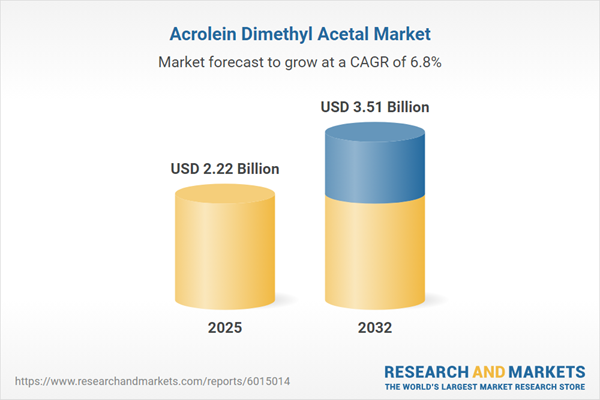Speak directly to the analyst to clarify any post sales queries you may have.
Senior executives in the specialty chemicals industry are facing an evolving landscape, requiring adaptive strategies amid new regulatory demands, disruptive technologies, and shifts in supply networks. Effective navigation of the acrolein dimethyl acetal market will depend on data-backed decision-making, with operational resilience and strategic positioning more crucial than ever.
Market Snapshot: Acrolein Dimethyl Acetal Market Size and Growth Overview
The acrolein dimethyl acetal market stands at USD 2.08 billion in 2024, with a projected rise to USD 2.22 billion in 2025 and reaching USD 3.51 billion by 2032. Strong gains are being driven by increased demand for advanced chemical intermediates, rapid adoption of process automation, and a strategic shift toward centralized, digitally managed supply chains. Suppliers are enhancing the scalability of distribution networks to meet the needs of a broadening client base and expanding geographic footprint. Businesses are responding with resilient, adaptive strategies that address shifting production imperatives and the complex realities of the specialty chemicals sector.
Scope & Segmentation: Comprehensive Acrolein Dimethyl Acetal Market Coverage
- Applications: Acrolein dimethyl acetal acts as a key intermediate in herbicide and pesticide manufacturing, supports specialty chemical synthesis, is used in automotive and industrial coatings, contributes to pharmaceutical formulations and excipients, is blended in plasticizer applications, and serves as a solvent in various manufacturing processes.
- Grade: Available in both industrial grades for cost-sensitive procurement and pharmaceutical grades for use in regulated, high-purity contexts requiring compliance.
- Purity Levels: Offered in purities from below 95%, through 95–99% for technical operations, to over 99% where compliance and value-added performance are priorities.
- End Use Industries: Customers include agrochemical producers, paints and coatings manufacturers, pharmaceutical companies, and plastics processors, each requiring tailored sourcing and compliance approaches to align with sectoral standards.
- Distribution Channels: Market access is provided via direct supply agreements with major manufacturers for bulk buyers, traditional distribution within established industrial networks, and digitally enabled procurement solutions to support visibility, efficiency, and traceability.
- Regional Analysis: Coverage spans the Americas, Europe, Middle East & Africa, and Asia-Pacific, with market dynamics shaped by regulatory conditions, local infrastructure investment, and context-specific operational demands.
- Leading Producers: Key players include BASF SE, Dow Inc., Evonik Industries AG, Arkema S.A., DuPont de Nemours, Mitsubishi Chemical Holdings Corporation, Sumitomo Chemical Co., Eastman Chemical Company, LANXESS AG, and Ashland Global Holdings Inc., each focusing on technological progress and regulatory compliance.
Key Takeaways: Strategic Insights for Executive Leadership
- Ongoing investment in process automation and digital platforms is enhancing business efficiency, sustainability, and value delivery throughout the chemical value chain.
- Organizations are moving toward renewable and bio-based feedstock sources to promote supply chain resilience and support the circular economy agenda.
- Procurement strategies are increasingly shaped by the need for product traceability, prioritizing high-purity inputs and comprehensive supply validation processes.
- Differing regulatory and customer requirements across regions necessitate targeted, policy-sensitive expansion strategies, with careful consideration of local infrastructure.
- Mid-sized companies are gaining flexibility and speed by employing adaptable production systems and leveraging digital sales channels to adjust to shifting competition and customer expectations.
- Close collaboration among manufacturers, distributors, and technology providers is advancing operational transparency, driving the adoption of enhanced digital tools, and strengthening risk management in specialty chemical markets.
Tariff Impact: Navigating US 2025 Policy Changes
Anticipated US tariff changes in 2025 are prompting North American producers to adapt sourcing, inventory, and procurement strategies. Senior leaders are considering nearshoring, renegotiating supplier terms, and refining inventory management practices to ensure cost stability. Early tariff relief discussions are helping secure reliable supply and uphold distribution performance amid new policy realities.
Methodology & Data Sources: Delivering Reliable Market Intelligence
Market intelligence for acrolein dimethyl acetal is compiled from secondary research across regulatory documentation, patent analyses, and recognized industry reports. Insights are validated with executive conversations, domain expertise, procurement studies, and specialist workshops focused on digital transformation and regulatory developments.
Why This Report Matters: Actionable Value for Market Leaders
- Enables senior leadership to proactively address regulatory changes, supply chain shifts, and digital transformation within specialty chemicals.
- Delivers well-structured segmentation and actionable market insights, supporting robust, risk-mitigated decisions in procurement and distribution planning.
- Facilitates advancement in sustainability and compliance strategies, strengthening organizational response to evolving operational demands.
Conclusion
Executives can leverage this analysis to guide strategic planning, justify investment actions, and enhance business sustainability as the global market for acrolein dimethyl acetal evolves.
Additional Product Information:
- Purchase of this report includes 1 year online access with quarterly updates.
- This report can be updated on request. Please contact our Customer Experience team using the Ask a Question widget on our website.
Table of Contents
3. Executive Summary
4. Market Overview
7. Cumulative Impact of Artificial Intelligence 2025
Companies Mentioned
The companies profiled in this Acrolein Dimethyl Acetal market report include:- BASF SE
- Dow Inc.
- Evonik Industries AG
- Arkema S.A.
- DuPont de Nemours, Inc.
- Mitsubishi Chemical Holdings Corporation
- Sumitomo Chemical Co., Ltd.
- Eastman Chemical Company
- LANXESS AG
- Ashland Global Holdings Inc.
Table Information
| Report Attribute | Details |
|---|---|
| No. of Pages | 181 |
| Published | November 2025 |
| Forecast Period | 2025 - 2032 |
| Estimated Market Value ( USD | $ 2.22 Billion |
| Forecasted Market Value ( USD | $ 3.51 Billion |
| Compound Annual Growth Rate | 6.7% |
| Regions Covered | Global |
| No. of Companies Mentioned | 11 |









